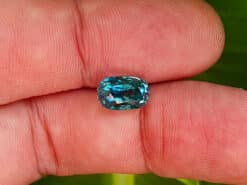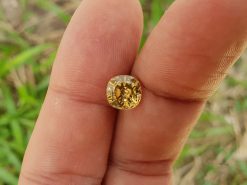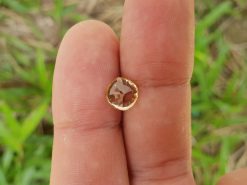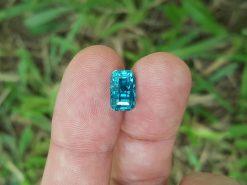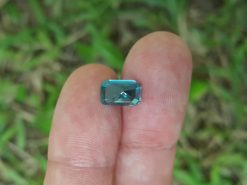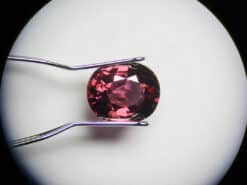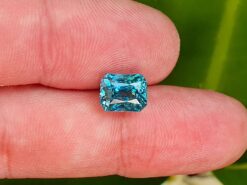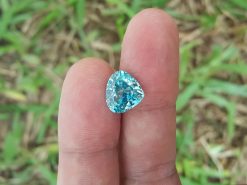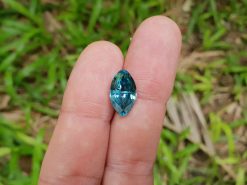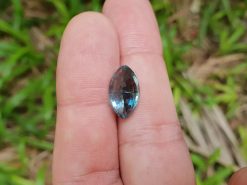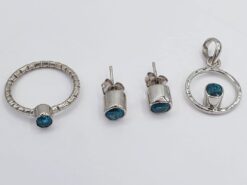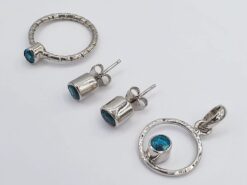Zircons, from Sri Lanka

Buy natural zircons in our gem shop
Introduction to Zircon
Zircon is a mineral belonging to the group of nesosilicates. Its chemical name is zirconium silicate, and its corresponding chemical formula is ZrSiO4. A common empirical formula showing some of the range of substitution in zircon is (Zr1–y, REEy)(SiO4)1–x(OH)4x–y.
Zircon forms in silicate melts with large proportions of high field strength incompatible elements. For example, hafnium is almost always present in quantities ranging from 1 to 4%. The crystal structure of zircon is tetragonal crystal system.
Colors and Varieties of Zircon
The natural color of zircon varies between colorless, yellow-golden, red, brown, blue, and green. Colorless specimens that show gem quality are a popular substitute for diamond and are also known as “Matura diamond.” The name derives from the Persian zargun, meaning “gold-hued.” This word was later adapted into “jargoon,” a term historically applied to light-colored zircon gems. The English word “zircon” is derived from Zirkon, the German adaptation of this Persian term. Yellow, orange, and red specimens have also been referred to as “hyacinth,” after the flower hyacinthus, whose name is of Ancient Greek origin.
Occurrence and Formation
Zircon is ubiquitous in Earth’s crust. It occurs as a common accessory mineral in igneous rocks, in metamorphic rocks, and as detrital grains in sedimentary rocks. Large zircon crystals are rare. Their average size in granite rocks is about 0.1–0.3 mm, but they can also grow to sizes of several centimeters, especially in mafic pegmatites and carbonatites. This mineral is also very resistant to heat and corrosion.
Metamictization and Its Effects
Because of their uranium and thorium content, some stones undergo
metamictization. Connected to internal radiation damage, these processes partially disrupt the crystal structure and partly explain the highly variable properties of zircon. As zircon becomes more and more modified by internal radiation damage, the density decreases, the crystal structure is compromised, and the color changes over time.
Color Changes and Heat Treatment
Zircon occurs in many colors, including reddish brown, yellow, green, blue, gray, and colorless. The color of certain specimens can sometimes be changed by heat treatment. Common brown stones can be transformed into colorless and blue hues by heating to about 800 to 1000 °C.
In geological settings, the development of pink, red, and purple zircon takes place over hundreds of millions of years, if the crystal has sufficient trace elements to form color centers. Color in this pinkish to reddish series is annealed in conditions above temperatures of around 400 °C.
Gemological Properties and Significance
In the realm of gemology, zircon is admired for its strong brilliance and notable double refraction. Its refractive index can be quite high, giving properly cut gems a remarkable sparkle. Zircon typically ranges from 6.5 to 7.5 on the Mohs hardness scale, meaning it is durable enough for most types of jewelry if treated with care. This gem’s resistance to chemical weathering also makes it important in geology for dating and studying Earth’s history, since its crystal lattice can incorporate elements like uranium and thorium.
Caring for Your Zircon
Maintaining the beauty of zircon requires some attention to cleaning and storage. Since it can exhibit varying levels of wear-resistance depending on the degree of internal radiation damage, it is generally recommended to clean zircon with a soft brush and mild soapy water. Avoid sudden temperature changes and exposure to harsh chemicals. Storing it separately from harder stones can help prevent surface abrasions.
Natural zircons, from Sri Lanka
FAQ
How can I tell if my zircon is natural?
A reputable gemological lab report is the most reliable way to confirm whether a zircon is natural. Gemological tests for refractive index, birefringence, and specific gravity are often used to distinguish genuine stones from synthetics or imitations.
Does zircon require any special care?
Although zircon is relatively durable, it’s best to clean it gently with lukewarm soapy water and a soft brush. Avoid abrupt temperature changes, harsh chemicals, and ultrasonic cleaners, especially if the stone has areas of structural alteration.
Why does zircon sometimes appear cloudy?
Cloudiness can result from metamictization caused by internal radiation damage. Over time, some specimens may lose a portion of their original crystal structure, which can affect their clarity and luster.
Can I wear zircon jewelry every day?
Many people do wear zircon daily, but be mindful that its hardness can vary slightly based on structural integrity. To preserve its brilliance, remove zircon jewelry before engaging in activities that may cause heavy impacts or abrasion.
Is blue zircon naturally occurring?
Blue zircon can form through natural geological processes, though it is often produced by heat-treating brownish or other pale-colored stones. The heated variety remains highly valued for its striking hue and brilliance.

